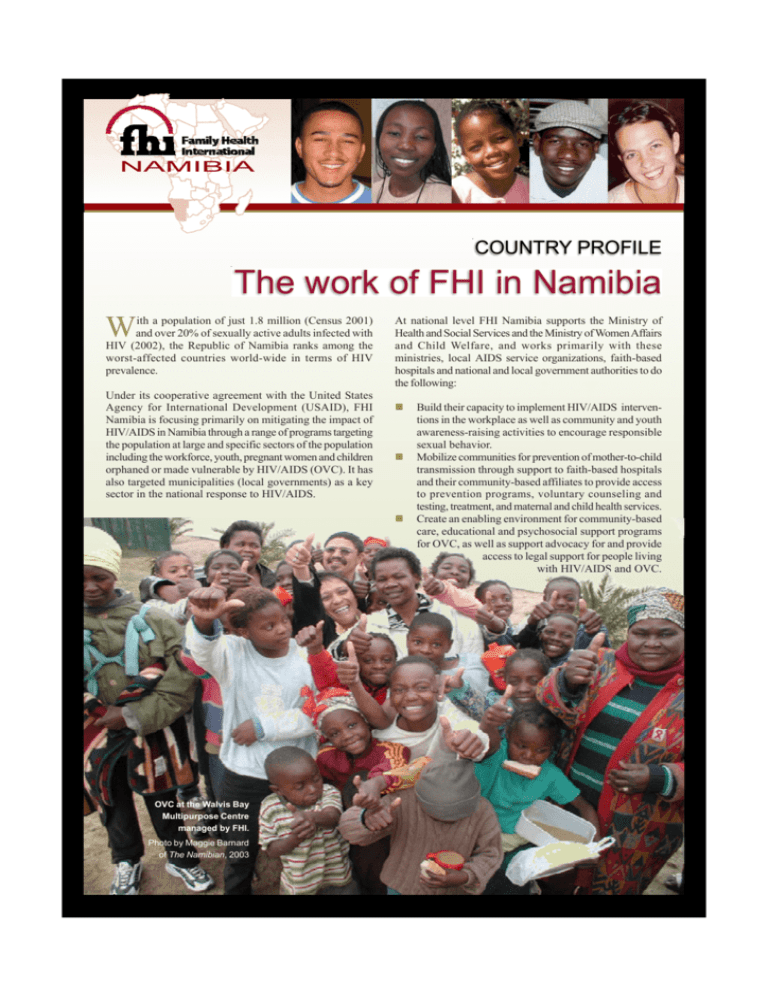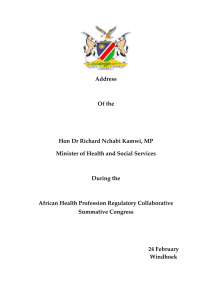FHI Namibia Programs
advertisement

NAMIBIA COUNTRY PROFILE The work of FHI in Namibia W ith a population of just 1.8 million (Census 2001) and over 20% of sexually active adults infected with HIV (2002), the Republic of Namibia ranks among the worst-affected countries world-wide in terms of HIV prevalence. Under its cooperative agreement with the United States Agency for International Development (USAID), FHI Namibia is focusing primarily on mitigating the impact of HIV/AIDS in Namibia through a range of programs targeting the population at large and specific sectors of the population including the workforce, youth, pregnant women and children orphaned or made vulnerable by HIV/AIDS (OVC). It has also targeted municipalities (local governments) as a key sector in the national response to HIV/AIDS. OVC at the Walvis Bay Multipurpose Centre managed by FHI. Photo by Maggie Barnard of The Namibian, 2003 At national level FHI Namibia supports the Ministry of Health and Social Services and the Ministry of Women Affairs and Child Welfare, and works primarily with these ministries, local AIDS service organizations, faith-based hospitals and national and local government authorities to do the following: Build their capacity to implement HIV/AIDS interventions in the workplace as well as community and youth awareness-raising activities to encourage responsible sexual behavior. Mobilize communities for prevention of mother-to-child transmission through support to faith-based hospitals and their community-based affiliates to provide access to prevention programs, voluntary counseling and testing, treatment, and maternal and child health services. Create an enabling environment for community-based care, educational and psychosocial support programs for OVC, as well as support advocacy for and provide access to legal support for people living with HIV/AIDS and OVC. NAMIBIA “FHI’s philosophy is to work directly with government line ministries, NGOs and communities to build their capacity to achieve their identified needs ... . Comprehensive and cost-effective approaches, coupled with coordinated partnerships and community mobilization, are needed to mitigate the impacts of HIV/AIDS.” – FHI Namibia Country Director Ms Rose De Buysscher FHI Namibia Programs Oshana Ohangwena Omusati T he FHI Namibia country program initially targeted three of the country’s thirteen regions (Khomas, Erongo and Oshana), HIV prevalence rates in these regions being among the highest in the country. In 2003, with the implementation of the PMTCT+ program (see below), the country program was expanded to cover an additional six regions, all but one of these (Hardap) also having among the highest prevalence rates in the country. Hardap is being targeted to prevent an escalation in HIV prevalence in some of the more densely populated parts of southern Namibia. These are the nine regions targeted under the expanded program: Hardap Khomas Erongo Otjozondjupa Oshana Omusati Oshikoto Ohangwena Kavango Kavango Oshikoto Kunene Ot jo zo n u dj pa Omaheke Erongo Khomas Hardap Cap rivi HIV Prevalence in Namibia (2002) 5-9% 10-14% 15-19% 20-24% 25-29% Karas 30-34% >40% The four main FHI Namibia areas of intervention are as follows. WORKPLACE PROGRAM Targeting the workplace through capacity-building of local NGOs Primary aim The workplace program targets the Namibian workforce at large by means of building the capacity of local NGOs and institutions to provide a comprehensive HIV/AIDS workplace package to the private, public, parastatal and local government sectors. Implementing partners AIDS Care Trust (Windhoek) Legal Assistance Centre AIDS Law Unit (Windhoek) Chamber of Mines (Windhoek) Walvis Bay Multipurpose Centre Sam Nujoma Multipurpose Centre (Ongwediva) Hansa Breweries HIV/AIDS Peer Education graduates, 2003 TREATMENT, CARE AND SUPPORT PROGRAM Targeting pregnant women and people living with HIV and AIDS Primary aim Under a new US Government initiative FHI Namibia has launched a treatment, care and support program for people with HIV and AIDS which enables five faith-based hospitals and their community-based affiliates to offer prevention programs, voluntary counseling and testing (VCT), maternal and child health services to prevent mother-to-child transmission of HIV, antiretroviral treatment (ART) and home-based care. Implementing partners Catholic Health Services Lutheran Medical Services Catholic AIDS Action (CAA) Lifeline/Childline Namibia Evangelical Lutheran Church in Namibia (ELCIN) Evangelical Lutheran Church AIDS Programme (ELCAP) “I am particularly thrilled to see how far the Multipurpose Centre has gone to achieve its goals and to see how well it has served the community of Walvis Bay.” – Deputy Minister of Health and Social Services Dr Richard Kamwi “The Multipurpose Centre is the heartbeat of the Municipality’s external HIV/AIDS response program and the most important HIV/AIDS-related asset we have.” – Walvis Bay Municipality Chief of Health Services Mr Flip Els NAMIBIA YOUTH PROGRAM Reaching in- and out-of-school youth Primary aim The FHI Namibia youth program targets in- and out-ofschool youth with the primary aim of building the capacity of young Namibians to avoid unsafe sexual practices and to cope with the impacts of HIV/AIDS. Implementing partners The Namibian YouthPaper Lifeline/Childline Namibia Walvis Bay Multipurpose Centre Sam Nujoma Multipurpose Centre Ombetja Yehinga (Red Ribbon) Program Change of Lifestyle Homes Project (COLS) President Sam Nujoma (centre left) with staff and partners of the Sam Nujoma Multipurpose Centre at the center’s opening in 2003. The center is dedicated to President Nujoma for his commitment to the development of the Namibian people. Initiatives under the program The Namibian YouthPaper – a weekly supplement of The Namibian (English daily newspaper); FHI supports the “Reproductive Health” page. “Feeling Yes, Feeling No” – a participatory program for school children being implemented by Lifeline/ Childline Namibia in schools countrywide, focusing on improving children’s verbal communication skills in interacting with peers and adults, and on teaching children about sexuality, sexual abuse, HIV/AIDS and violence. Walvis Bay Multipurpose Centre – a community development center managed by FHI providing information, education and training on a range of topics in a youth-friendly atmosphere, facilities catering for a range of activities for young people, and access to social services and HIV/AIDS-related services. Sam Nujoma Multipurpose Centre – a community development project in the town of Ongwediva in the Oshana Region aimed at improving the quality of life of people in the area by providing a variety of programs and community services including youth programs, OVC support programs, and HIV/AIDS prevention, care and support programs. Ombetja Yehinga (Red Ribbon) Program – an HIV/ AIDS awareness project operating in the Kunene and Erongo Regions in north-western Namibia aimed at reaching school-going youth through a participatory process with teachers and learners in the education system and with external HIV/AIDS Clubs. Namibia YouthNet Program – a program initiated by FHI Namibia and implemented through COLS, focusing on the role of churches and faith-based organizations (FBOs) in working with youth around HIV/AIDS. A YouthNet meeting FACTS AND FIGURES: HIV/AIDS PREVALENCE IN NAMIBIA Namibia’s birth rate of 35 births and death rate of 22.28 deaths per 1 000 population contribute to an overall population growth rate of 1.6%. Life expectancy at birth is a very low 41 years for women and 44 for men. The total fertility rate is 4.9 children per woman, and there is a high infant mortality rate of 72 deaths per 1 000 live births. The 2002 national HIV sentinel surveillance at antenatal clinics indicated a national HIV prevalence of 22% in pregnant women. At most survey sites where previous data was available it was found that prevalence among pregnant women had continued to increase. Consequently, the number of Namibian children losing their mother or both parents to AIDS is increasing from an estimated total of 31 000 in 1999 to a projected 118 000 by 2006. The same survey indicates a slight overall drop in HIV prevalence from 12% to 11% in the 15-19 age group in the period 20002002, but an increase from 20% to 22% in the 20-24 age group in the same period. Overall, prevalence in Namibia increases rapidly from 11% in the 15-19 age group to 22% in the 20-24 age group, peaking at 28% in the 25-29 age group. UNAIDS estimates an overall HIV prevalence rate of 22.5% as of 2001 with 230 000 people living with HIV/AIDS and 13 000 AIDS-related deaths in 2001 alone. NAMIBIA “I am often referred to as ‘the Mother of the Nation’, but I am sure you will agree that no mother would be able to cope with all these children in need, and that is why you are here and why I am relying on you to help me in this endeavour.” – First Lady Ms Kovambo Nujoma in her speech to the 2nd National Conference on OVC (2002) co-funded by USAID, FHI, UNICEF and the Namibian Government OVC PROGRAM Care and support for orphans and other vulnerable children (OVC) Primary aim The FHI Namibia OVC program supports a set of holistic initiatives implemented by the government and NGOs in support of OVC. Implementing partners Ministry of Women Affairs and Child Welfare Catholic AIDS Action Philippi Trust Namibia AIDS Law Unit of the Legal Assistance Centre Initiatives supported by FHI National OVC Program of the Government of Namibia – a program overseen by the Permanent OVC Task Force resorting under the Ministry of Women Affairs and Child Welfare and supported by national and international NGOs and donor agencies including FHI. “Schooled for Success: Promoting Full School Participation by OVC” – a Catholic AIDS Action program aimed at ensuring that OVC attend school and succeed in their schooling, to date incorporating a major campaign on the right of OVC to attend school and the provision of uniforms and other school supplies to qualifying OVC. Psychosocial Training for OVC – a Philippi Namibia program aimed at training peer counselors for young people and identifying potential youth leaders for further training to assist OVC, and at counseling OVC and helping them to overcome their difficulties and fears through experiential learning. (Philippi Namibia is a branch of Philippi Trust International.) AIDS Law Unit of the Legal Assistance Centre – an advocacy project focusing on entrenching the rights of people living with HIV/AIDS and the rights of OVC, and ensuring their access to legal support. FHI Namibia continuously produces or commissions printed materials (reports, information booklets, posters, etc.) on different topics in its areas of interest for distribution to partners and for public consumption. Young Namibian girls participating in an after-school program for girls run by Catholic AIDS Action with FHI support. FHI NAMIBIA CONTACT DETAILS + 351 Sam Nujoma Drive, Klein Windhoek P.O. Box 90199, Klein Windhoek, Namibia (+264) (+61) 239463 (+264) (+61) 239461 Email info@fhi.org.na Website http://www.fhi.org.na






